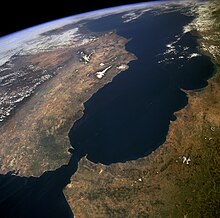Alboran Sea: Difference between revisions
Fama Clamosa (talk | contribs) more geology |
Rescuing 1 sources and tagging 0 as dead. #IABot (v1.2.4) |
||
| Line 7: | Line 7: | ||
Its average depth is {{Convert|1461|ft|m}} and maximum depth is {{Convert|4920|ft|m}}. |
Its average depth is {{Convert|1461|ft|m}} and maximum depth is {{Convert|4920|ft|m}}. |
||
The [[International Hydrographic Organization]] defines the limits of the Alboran Sea as follows:<ref>{{cite web|url=http://www.iho-ohi.net/iho_pubs/standard/S-23/S23_1953.pdf|title=Limits of Oceans and Seas, 3rd edition|year=1953|publisher=International Hydrographic Organization|accessdate=7 February 2010}}</ref> |
The [[International Hydrographic Organization]] defines the limits of the Alboran Sea as follows:<ref>{{cite web|url=http://www.iho-ohi.net/iho_pubs/standard/S-23/S23_1953.pdf |title=Limits of Oceans and Seas, 3rd edition |year=1953 |publisher=International Hydrographic Organization |accessdate=7 February 2010 |deadurl=yes |archiveurl=https://web.archive.org/web/20111008191433/http://www.iho-ohi.net/iho_pubs/standard/S-23/S23_1953.pdf |archivedate=8 October 2011 |df= }}</ref> |
||
<blockquote> |
<blockquote> |
||
Revision as of 20:36, 7 October 2016
36°0′N 3°0′W / 36.000°N 3.000°W

The Alboran Sea is the westernmost portion of the Mediterranean Sea, lying between the Iberian Peninsula and the north of Africa. The Strait of Gibraltar, which lies at the west end of the Alboran Sea, connects the Mediterranean with the Atlantic Ocean.
Geography
Its average depth is 1,461 feet (445 m) and maximum depth is 4,920 feet (1,500 m).
The International Hydrographic Organization defines the limits of the Alboran Sea as follows:[1]
On the West. The Eastern limit of the Strait of Gibraltar: A line joining from tip (Europa Point) of Cap Gibraltar in Europe to the tip of the Península de Almina of Ceuta in Africa (35°54′N 5°18′W / 35.900°N 5.300°W).
On the East. A line joining from Cabo de Gata in Andalusia in Europe to Cap Fegalo in Algeria in Africa (35°36′N 1°12′W / 35.600°N 1.200°W).
Several small islands dot the sea, including the eponymous Isla de Alborán. Most, even including those close to the Moroccan shore are controlled by Spain.
Geology
The Alboran domain, the seafloor beneath the Alboran Sea (known as the internal zones) together with the surrounding mountains (known as the external zones; the Gibraltar Arc and Atlas Mountains), is mostly made of continental crust and marks the western-most terminus of the terranes that were subducted between the African and Eurasian Plates when the Tethys Ocean closed. Reoccurring earthquakes at a depth of about 600 km (370 mi) indicates that this subduction is ongoing and that complex interactions between the lithosphere and mantle are forming the region.[2] The internal zones are made of Late Paleozoic to Triassic rocks that were piled up during the Tertiary and has been extended since the Early Miocene.[3]
The seafloor is morphologically complex with several sub-basins, including three main sub-basins named West, East, and South Alboran Basins, ridges, and seamounts. The most prominent structure in the Alboran Sea is the 180 km (110 mi)-long Alboran Ridge which stretches southwest from the volcanic Alborán Island.[4]
Oceanography
Surface currents in the Alboran Sea, influenced by the prevailing winds, flow eastward, bringing water from the Atlantic into the Mediterranean; deeper subsurface currents flow westward, carrying saltier Mediterranean water over the Gibraltar sill into the Atlantic. Thus there is typically a vertical rotary circulation, also known as a gyre, in the Alboran Sea as a result of this exchange of water.[5]
Ecology

The Alboran Sea is a transition zone between ocean and sea, containing a mix of Mediterranean and Atlantic species. The Alboran Sea is habitat for the largest population of bottlenose dolphins in the western Mediterranean, is home to the last population of harbour porpoises in the Mediterranean, and is the most important feeding grounds for loggerhead sea turtles in Europe. The Alboran sea also hosts important commercial fisheries, including sardines and swordfish. In 2003, the World Wildlife Fund raised concerns about the widespread drift net fishing endangering populations of dolphins, turtles, and other marine animals.
An arc of mountains, known as the Gibraltar Arc, wraps around the northern, western, and southern sides of the Alboran Sea. The Gibraltar Arc is made up of the Baetic Cordillera of southern Spain and the Rif Mountains of Morocco. These mountains, known to ecologists as the Baetic-Rifan complex, comprise one of the Mediterranean's biodiversity hotspots; like the Alboran sea, the Baetic-Rifan complex represents a transition between the Mediterranean and Atlantic (Macaronesian) ecological zones. The moderating influence of the Atlantic has allowed many relict species in the Baetic and Rif mountains to survive the climatic fluctuations of the last few million years that have caused them to become extinct elsewhere around the Mediterranean basin.
References
Notes
- ^ "Limits of Oceans and Seas, 3rd edition" (PDF). International Hydrographic Organization. 1953. Archived from the original (PDF) on 8 October 2011. Retrieved 7 February 2010.
{{cite web}}: Unknown parameter|deadurl=ignored (|url-status=suggested) (help) - ^ Alpert et al. 2013, Introduction, pp. 4265–4266
- ^ Iribarren et al. 2007, Introduction, p. 98
- ^ Comas et al. 1999, p. 559
- ^ C. Michael Hogan. 2011. "Alboran Sea" in. eds. P.Saundry & C.J.Cleveland. Encyclopedia of Earth. (National Council for Science and the Environment) Washington DC
Sources
- Alpert, L. A.; Miller, M. S.; Becker, T. W.; Allam, A. A. (2013). "Structure beneath the Alboran from geodynamic flow models and seismic anisotropy" (PDF). Journal of Geophysical Research: Solid Earth. 118 (8): 4265–4277. doi:10.1002/jgrb.50309. Retrieved November 2015.
{{cite journal}}: Check date values in:|accessdate=(help); Invalid|ref=harv(help) - Comas, M. C.; Platt, J. P.; Soto, J. I.; Watts, A. B. (1999). "44. The origin and tectonic history of the Alboran Basin: insights from Leg 161 results" (PDF). Proceedings of the Ocean Drilling Program Scientific Results. Vol. 161. pp. 555–580. Retrieved October 2015.
{{cite book}}: Check date values in:|accessdate=(help); Invalid|ref=harv(help) - Iribarren, L.; Vergés, J.; Camurri, F.; Fullea, J.; Fernandez, M. (2007). "The structure of the Atlantic–Mediterranean transition zone from the Alboran Sea to the Horseshoe Abyssal Plain (Iberia–Africa plate boundary" (PDF). Marine Geology. 243 (1): 97–119. doi:10.1016/j.margeo.2007.05.011. Retrieved November 2015.
{{cite journal}}: Check date values in:|accessdate=(help); Invalid|ref=harv(help)
